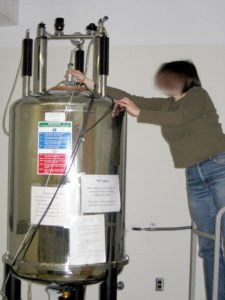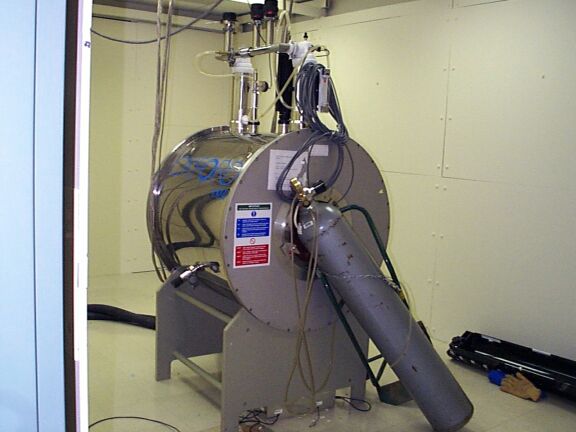- Example No. 1: How to Break Your NMR Sample Tube in the Magnet
- Example No. 2: Compressed Gas Cylinder Quenches Imaging Magnet
- Example No. 3: Serious Injuries from MRI-Accident
- Example No. 4: Nitrogen Safety Warning
Example No. 1: How to Break Your NMR Sample Tube in the Magnet

Here is a photo illustrating a most effective technique to break an NMR sample tube at the top of the upper barrel, thus potentially (1) contaminating the probe, (2) putting the spectrometer out of commission for an extended length of time, (3) causing several thousands of dollars worth of repair costs, (4) incurring the wrath of the NMR user community, and ultimately (5) losing your own access to the NMR Facility. As a bonus, this photo also illustrates two additional and inappropriate actions, namely (1) enhancing the risk of a fall due to improper placement of the ladder and thus overextending beyond a safe reach distance, and (2) leaning on a magnet that is suspended by vibration-damping pneumatic legs.
Example No. 2: Compressed Gas Cylinder Quenches Imaging Magnet
 Here is a photo from the University of Illinois, Urbana–Champaign, of a partially quenched horizontal magnet holding onto a gas cylinder and cart. The photo and information were provided (in 2002) by:
Here is a photo from the University of Illinois, Urbana–Champaign, of a partially quenched horizontal magnet holding onto a gas cylinder and cart. The photo and information were provided (in 2002) by:
- William C. Stevens, PhD
NMR Facility Director
Southern Illinois University
Carbondale, IL 62901-4405
Example No. 3: Serious Injuries from MRI-Accident
Due to a short-circuit in the MRI console of a Freiburg hospital (August 2001), heavy smoke penetrated into the adjacent rooms. Unfortunately the well-trained and competent staff was asked to leave the area, and so nobody knew that in spite of turning off all power supply the magnet was still energized. During a check-up round a fireman with full breathing equipment was drawn into the bore where he got stuck. Only after quenching the magnet could he be saved, suffering serious injuries. (See “Brandschutz” Deutsche Feuerwehr-Zeitung 3/2002 p. 281 ff.) As a consequence the fire department told us to establish a fixed stoppage around all magnets greater than 10 Tesla at the campus. This information was provided (in 2002) by:
- Dr. Johannes Gottfried Zimmermann
Goethe-Universität Frankfurt
Institut für Organische Chemie
Marie-Curie-Str. 11
D-60439 Frankfurt
Example No. 4: Nitrogen Safety Warning
Due to cost reasons, the liquid nitrogen is produced at some universities by small liquifier machines. The quality with respect to oxygen content of this nitrogen varies between 0.1 and 5%, of course, dependent on liquifier performance and operator skill. Whereas this is probably not important for everyday laboratory use, the consumption of this type of nitrogen in long-hold dewars, e.g. NMR magnets, may pose a problem. Mass spectrometric analysis of the content in seven magnets at our place, which were without uninterruption filled by this type of nitrogen since years, indicated last week a nitrogen:oxygen ratio approaching 1:1 (!). We are currently debating on the most efficient and safe way to remove the problem. This information was provided (in 2002) by:
- Prof. Dr. Stefan Berger
Institut für Analytische Chemie
Universität Leipzig Linnéstr.
3 D-04103 Leipzig